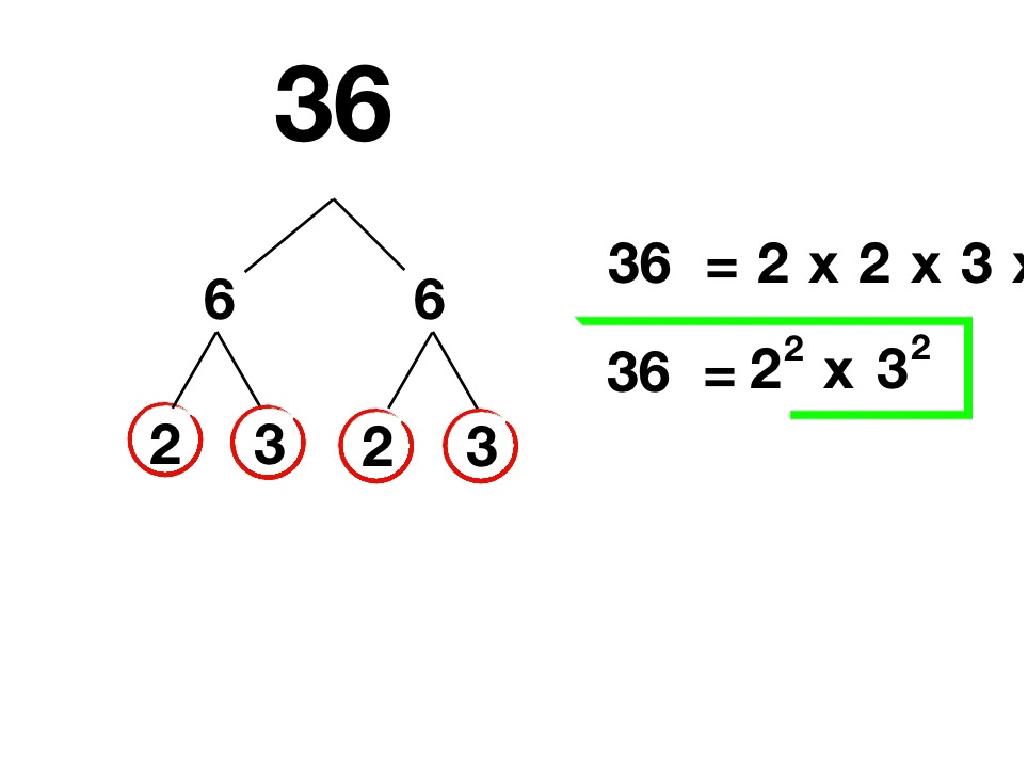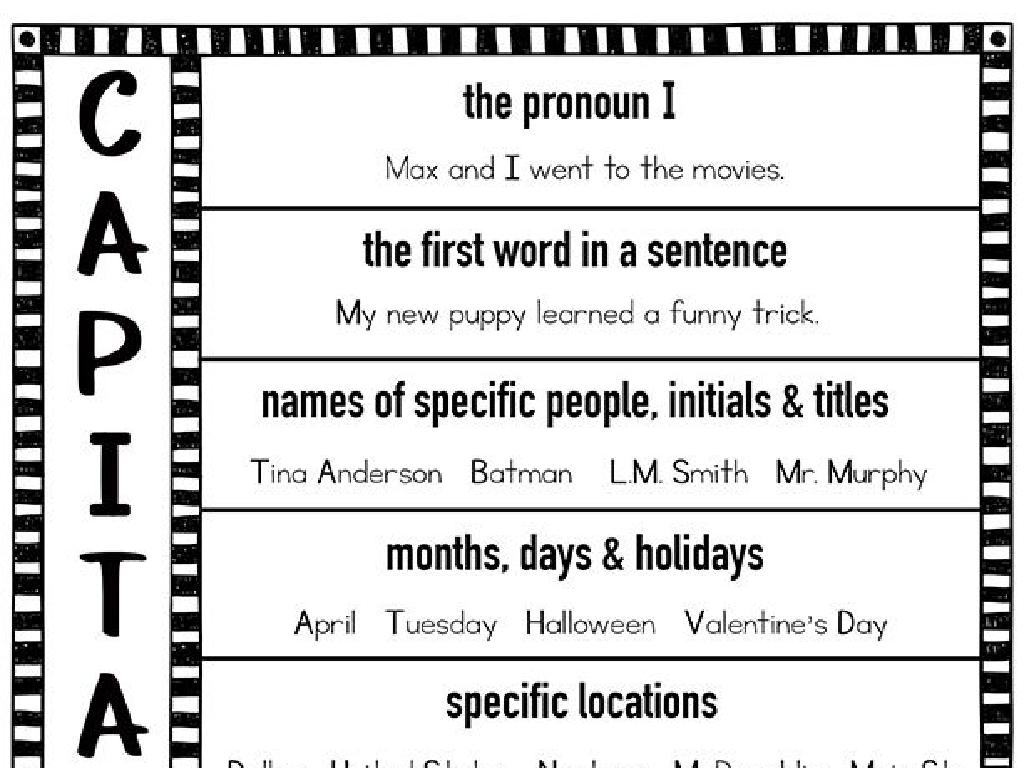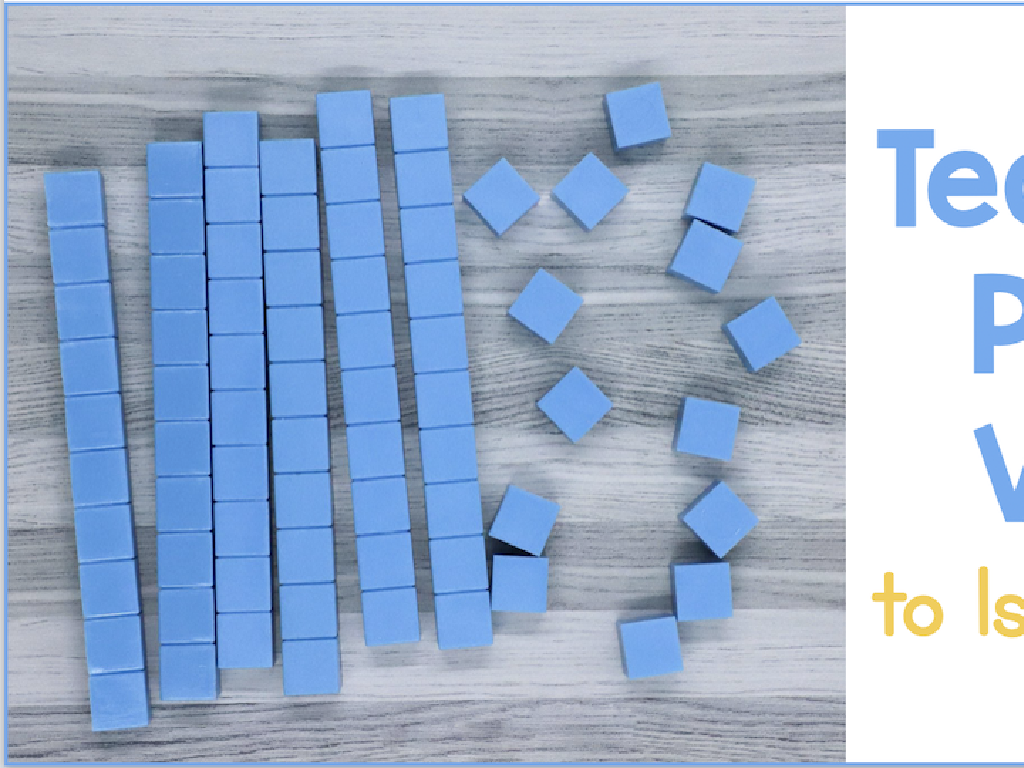Name Countries Of South America
Subject: Social studies
Grade: Sixth grade
Topic: The Americas: Geography
Please LOG IN to download the presentation. Access is available to registered users only.
View More Content
Welcome to South America!
– Discover the South American continent
– Today’s goal: Learn South American countries
– We’ll explore each of the 12 sovereign countries
– Geography shapes our global view
– Understanding geography helps us appreciate cultural and environmental diversity
– Engage with the diverse South American geography
– From the Amazon rainforest to the Andes mountains, geography is key to the continent’s identity
|
This slide introduces students to the continent of South America and sets the stage for the day’s lesson, which is to learn about the countries that make up this diverse and culturally rich continent. Emphasize the importance of geography in understanding different regions of the world and how it affects cultures, environments, and global relationships. Encourage students to think about how geography can influence a country’s history, economy, and way of life. Use maps and images to help students visualize the continent’s geography, and prepare to dive into the specifics of each country in the following slides.
Exploring the Map: South America
– Locate South America on a map
– Interactive map activity
– Students will take turns pointing out South America on a globe or digital map
– Geographical features of South America
– Discuss the Andes, Amazon Basin, and Atacama Desert
– Understanding South America’s place in the world
– Compare South America’s size and location with other continents
|
This slide is designed to help students visually identify where South America is on a world map and to engage them in an interactive activity to reinforce their understanding. The activity involves students taking turns to locate South America on a globe or digital map, which will help them remember its position geographically. Highlight key geographical features such as the Andes mountain range, the Amazon Basin, and the Atacama Desert to give students a sense of the diverse topography of the continent. Encourage students to think about how these features might affect climate, biodiversity, and human activity. Finally, help students place South America in a global context by comparing its size and location relative to other continents. This will provide a foundation for understanding its role in global geography.
Exploring South America: Countries and Curiosities
– List of South American countries
– Brazil, Argentina, Colombia, and more
– Pronunciation guides for names
– Brazil (brah-ZEEL), Argentina (ahr-jen-TEE-nah)
– Fun facts to ignite curiosity
– Brazil is famous for its Carnival, Argentina for tango
– Engage with cultural uniqueness
– Explore the Amazon in Brazil, Andes mountains in Argentina
|
This slide aims to introduce students to the countries of South America, helping them to not only recognize and pronounce each country’s name but also to connect with each nation through interesting facts. Encourage students to practice the pronunciation together in class. The fun facts should be engaging and relevant, such as mentioning the Amazon rainforest in Brazil or the tango dance originating from Argentina. This will help students to remember the countries better and spark their interest in the geography and culture of South America. As an activity, students could be asked to find one additional fact about each country to share in the next class.
Capitals and Flags of South America
– Match countries with capitals
– Connect Brasília to Brazil, Bogotá to Colombia
– Explore flag symbolism
– Discuss colors, shapes, and emblems on flags
– Quick flag & capital quiz
– Test your knowledge on South American flags and capitals
– Engage with colorful visuals
|
This slide aims to familiarize students with the countries of South America by matching them with their capitals and flags. Start by presenting a map of South America with countries and capitals. Then, show each country’s flag and discuss the symbolism behind the colors and emblems. For example, the yellow on Colombia’s flag represents the gold found in the country, while the blue symbolizes the sea on the shores of Colombia. After the discussion, conduct a quick quiz to reinforce learning. Ask students to identify flags and capitals from the presentation. This interactive approach helps students to visually connect each country with its respective symbol and capital, enhancing their geographical literacy.
Cultural Glimpse of South America
– Explore cultural aspects
– Music, dance, festivals of Brazil, Argentina, etc.
– Discuss continental diversity
– Languages, traditions vary across countries
– Share personal connections
– Students may have family or stories linked to South America
– Reflect on cultural significance
|
This slide aims to introduce students to the rich cultural tapestry of South America. Highlight the importance of cultural elements like music, dance, and festivals, using Brazil’s samba and Argentina’s tango as examples. Discuss the diversity found within the continent, from the multitude of languages spoken to the variety of traditions and customs. Encourage students to share any personal or familial connections they may have to South America, fostering a more interactive and personal learning experience. Reflect on how these cultural aspects contribute to the continent’s identity and the world’s cultural heritage. This will help students appreciate the diversity and develop a global mindset.
Exploring South America’s Geography
– The Andes Mountains
– Longest continental mountain range in the world.
– The Amazon River
– Second longest river globally, flows through the rainforest.
– Significance of these features
– They are vital for biodiversity, climate, and human settlement.
– Map drawing activity
|
Begin the lesson by discussing the Andes Mountains, emphasizing their role as the backbone of South America and their impact on climate and human activities. Then, shift focus to the Amazon River, highlighting its importance as a habitat, a water source, and a means of transportation. Explain how these physical features contribute to the continent’s biodiversity and the livelihoods of people. For the activity, provide students with a blank map and guide them to draw and label the Andes Mountains and the Amazon River, reinforcing their understanding of the geography of South America. This hands-on activity will help students visualize and remember these significant geographical features.
Class Activity: Explore South American Countries
– Divide into groups for research
– Each group gets a country
– Research geography, capital, and flag
– Find one interesting fact
– Could be about culture, history, or a famous landmark
|
This activity is designed to encourage collaborative learning and research skills. Divide the class into small groups and assign each group a different South American country. Provide resources such as books, articles, and internet access for research. Each group will look into their country’s geography, including physical features and location, the capital city, the design and symbolism of the flag, and come up with an interesting fact about their country, which could be related to culture, history, or a significant landmark. Allow time for each group to prepare a short presentation to share their findings with the class. This will not only help them learn about South American countries but also improve their presentation skills. Possible activities for different students could include creating a poster, a PowerPoint presentation, a skit, or even a mock interview with a ‘resident’ of the country.
Recap: South American Geography
– Review countries and capitals
– Recall all 12 countries and their capitals
– Main geographical features
– Andes Mountains, Amazon Basin, and more
– Preview: South American cultures
– Explore the diverse cultures and traditions
– Engage with a quiz next class
|
This slide aims to summarize the key points from our lesson on South American geography. Start by revisiting the 12 countries and their capitals to reinforce memorization. Then, briefly discuss the main geographical features, such as the Andes Mountains, the Amazon Basin, and the Atacama Desert, to ensure students can associate these features with the correct locations. Introduce the next lesson on the cultures of South America, highlighting that we will explore the rich and diverse traditions, languages, and histories that make up the continent. To keep students engaged, mention that the next class will start with a fun quiz on the countries and capitals to test their knowledge.






